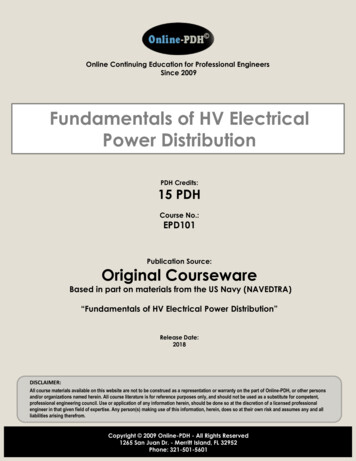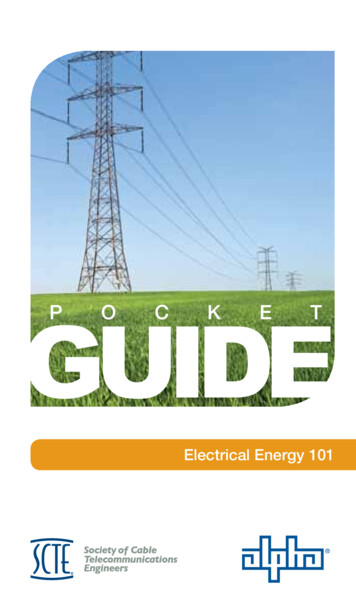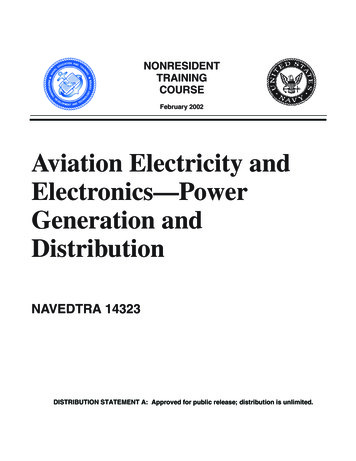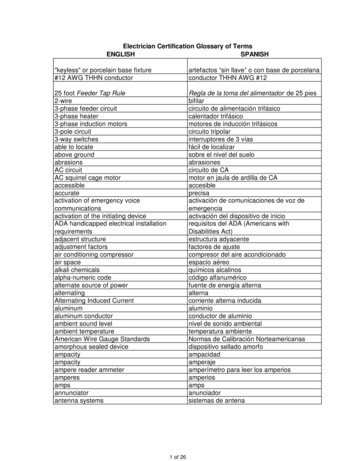
Transcription
Online Continuing Education for Professional EngineersSince 2009Fundamentals of HV ElectricalPower DistributionPDH Credits:15 PDHCourse No.:EPD101Publication Source:Original CoursewareBased in part on materials from the US Navy (NAVEDTRA)“Fundamentals of HV Electrical Power Distribution”Release Date:2018DISCLAIMER:All course materials available on this website are not to be construed as a representation or warranty on the part of Online-PDH, or other personsand/or organizations named herein. All course literature is for reference purposes only, and should not be used as a substitute for competent,professional engineering council. Use or application of any information herein, should be done so at the discretion of a licensed professionalengineer in that given field of expertise. Any person(s) making use of this information, herein, does so at their own risk and assumes any and allliabilities arising therefrom.Copyright 2009 Online-PDH - All Rights Reserved1265 San Juan Dr. - Merritt Island, FL 32952Phone: 321-501-5601
Fundamentals of HV Electrical PowerDistribution1Fundamentals of HV Electrical Power Distribution
Introduction2Fundamentals of HV Electrical Power Distribution
OverviewPower Distribution System - includes all parts of an electrical system between thepower source and the customer’s service entrance.It includes overhead and underground transmission methods and the equipmentrequired for the control and protection of the system and personnel.3Fundamentals of HV Electrical Power Distribution
Power SourceThe power source may be a local generating plant. Or it may be a high-voltagetransmission line feeding a substation that reduces high voltage to a level suitable forlocal distribution. Often, the source of power will be generators connected directly toa load.4Fundamentals of HV Electrical Power Distribution
Overhead Distribution SystemsThis course will be mainly concerned with the overhead distribution system. Generallyspeaking, an overhead distribution system can be installed and maintained moreefficiently than an underground system.Also, for equivalent conductor size, an overhead system has higher current capacityand offers greater flexibility for future system modifications.In this course, you will learn the basics in constructing and maintaining a powerdistribution system as well as the component parts of the system.5Fundamentals of HV Electrical Power Distribution
Safety Concerns in Power DistributionSafety is the most important topic covered in this course. The potential for an accidentis present during all construction and maintenance operations but is much greater forcrew members working on power distribution systems.High voltage conditions require heightened awareness of the potential for seriousinjury or death caused by carelessness and of the necessity of taking precautions toensure the safety of all personnel.6Fundamentals of HV Electrical Power Distribution
Safety with EquipmentCranes, earth augers, bucket trucks, and line trucks with booms capable of contactinghigh voltage lines because of their height must be operated with caution.Maintain a minimum separation of 10 feet between the equipment and the energizedpower circuits at all times.The equipment must be maintained in first-class mechanical condition., with “SAFETYFIRST” as the primary goal.7Fundamentals of HV Electrical Power Distribution
Personnel SafetyIt is the line crew’s responsibility to ensure the SAFETY of all personnel working onpower distribution lines, and observe the following safety precautions: Ensure that all hot-line equipment is routinely tested according to themanufacturer’s specifications before use. Ensure that all hot-line equipment, including rubber gloves, is stored inappropriate containers to provide the required physical protection. Perform air leak tests on rubber gloves before each use. Never use rubber gloves without the leather outer protectors. Ensure that the hard hats of crew members are rated to withstand 20,000 Vacand that no metal devices are or have been attached to them. Ensure all members of the line crew are trained in first-aid techniques for treatingvictims of electrical shock. Ensure that no individual is ever allowed to work alone near circuits or devicesconducting electrical energy over 30V AC. Tag and lock out all circuits that are de-energized to perform work. Install ground sets between the electrical source and your work on all deenergized circuits when the disconnecting means is not in sight or when thepotential for contact between the de-energized circuit and an energized circuit ispresent.8Fundamentals of HV Electrical Power Distribution
Minimum ClearancesMaintain a minimum of 3-foot clearance between personnel and any live powercircuit or device conducting between 600 and 20,000 Vac. Higher voltagesrequire an increased separation of personnel and energized circuits.The Lineman’s and Cableman’s Handbook, the Safety of Electrical Transmissionand Distribution Systems, MIL-HDBK-1025/10, and Occupational Safety andHealth Administration (OSHA) instructions are a few of the references you needto learn more about job safety.9Fundamentals of HV Electrical Power Distribution
Distribution Systems10Fundamentals of HV Electrical Power Distribution
Components of a Power Distribution SystemA power distribution system includes all elements of an electrical system between thepower source and the customer’s service entrance.The power source may be either a local generating plant or a high-voltagetransmission line feeding a substation that reduces the high voltage to a voltagesuitable for local distribution.Depending on the type of system, the distribution system will consist of somecombination of the following components, substations, distribution transformers,distribution lines, secondary circuits, secondary service drops, and safety andswitching equipment.The distribution system may be underground, overhead, or a combination of the two.11Fundamentals of HV Electrical Power Distribution
Distribution SubstationsDistribution substations change the transmission or generator voltage to a lower level,providing voltage sources for the distribution circuits supplying power to the customers.Substations may be attended by operators or designed for automatic or remote controlof the switching and voltage regulating equipment. Most large new substations are eitherautomatic or remotely controlled.12Fundamentals of HV Electrical Power Distribution
Distribution TransformersA distribution transformer is an electrical transformer used to carry electrical energyfrom a primary distribution circuit to a secondary distribution circuit.Distribution transformers are installed in the vicinity of each customer to reduce thevoltage of the distribution circuit to a usable voltage, usually 120/240 volts.The image above shows an example of a bank of 3 conventional type step-downdistribution transformers.13Fundamentals of HV Electrical Power Distribution
Step-up TransformersLong-distance transmission of electricity requires a voltage higher than normallygenerated. A step-up transformer is used to produce the high voltage (example above).Step-down TransformersAs most common electrical equipment will use 120/208 volts, a distribution transformer(step-down) is required to reduce the high-primary voltage to the utilization voltage of120/208 volts. The various types of transformer installations are discussed later in thiscourse.Transformer ProtectionRegardless of the type of installation or arrangement, transformers must be protected byfused cutouts or circuit breakers, and lightning arresters should be installed between thehigh-voltage line and the fused cutouts.14Fundamentals of HV Electrical Power Distribution
Types of Single-Phase Distribution TransformersThree general types of single-phase distribution transformers are in use today: Conventional type - requires a lightning arrester and fuse cutout on theprimary-phase conductor feeding the transformer. Self-protected (SP) type - has a built-in lightning protector. Completely self-protected (CSP) type - has the lightning arrester and currentoverload devices connected to the transformer and requires no separateprotective devices.15Fundamentals of HV Electrical Power Distribution
Primary Distribution CircuitsDistribution circuits (primary main circuits) originate from the distribution substation.Primary mains carry over 600 volts, but generally they operate between 2.4kv and34.5kv (kilovolts).Primaries can be found in single-phase or three-phase configurations and generallyoperate as three-phase, three-wire or three-phase, four-wire circuits.16Fundamentals of HV Electrical Power Distribution
Secondary CircuitsSecondary circuits (secondary mains) originate from the secondary windings of adistribution transformer and are 600 VAC or less.The secondary circuits are also configured either delta or wye and are also used for thesame type of loading as the primary circuits.Secondary circuits are either:Three phase - meaning they have three live conductorsSingle phase - which can be one or two live conductors and a neutral17Fundamentals of HV Electrical Power Distribution
Delta ConfigurationThe delta system is a three-phase, three-wire system configuration. The symbol for thedelta configuration is "Δ". Only one voltage exists in a delta system. This voltage isobtained between any two of the three phase conductors in the system.This is a phase to-phase connection and is therefore a LINE voltage.Since there is no neutral in a delta system, there is no potential from any energizedphase to neutral or ground as long as the delta system remains pure (no grounds).18Fundamentals of HV Electrical Power Distribution
Delta Type SystemThe delta type (Δ) system, shown above, is used when most of the load in an area iscommercial, consisting of motors and other three-phase equipment.19Fundamentals of HV Electrical Power Distribution
Wye ConfigurationThis system configuration is a three-phase, four-wire system and is the preferredsystem used by our military services. The symbol for the wye configuration is “Y ". Thewye system has two voltage potentials: LINE and PHASE.Phase-to-phase (LINE) voltage is obtained between any two of the three energizedphases. Phase-to-neutral (PHASE) voltage is obtained from any one of the threeenergized phases and the neutral conductor.The energized phases are designated with the first three letters of the alphabet: A, Band C (This phase designation applies to all systems). The neutral conductor is thefourth wire of this system and is designated with the letter N.20Fundamentals of HV Electrical Power Distribution
Neutral Conductor (in Wye System)The neutral conductor is connected to the ground at predetermined locations toensure that it remains a de-energized conductor.The earth also serves as an alternate path back to the voltage source if the neutralconductor should break its path.The neutral is not an energized conductor, but should be treated as such sinceaccidental opening of the conductor causes current to flow.21Fundamentals of HV Electrical Power Distribution
Wye Type SystemThe wye (Y) system, shown above, is used primarily for residential use and where lightingmakes up a substantial portion of the load.22Fundamentals of HV Electrical Power Distribution
Service DropsA service drop is the combined conductors used to provide an electrical connectionbetween a secondary distribution circuit and a user's facility (residential, commercial,industrial, etc.).There are different ways of installing the service drop. Some typical secondary racksused to install service drops are shown above.23Fundamentals of HV Electrical Power Distribution
Service RackWhether a rack has individual conductors or self-supporting service cable, known astriplex or quadraplex, to provide a service drop, you must maintain the minimumaboveground distance recommended by the NEC .In the example above, this distance is 12 feet over lawns, driveways, or walkwaysaccessible to pedestrians and 18 feet over roads or alleyways subject to truck traffic.When the nearest distribution pole is over 125 feet from the facility to be connected,you must provide an intermediate support pole*.* (Local code requirements should be consulted as well as the most recent edition ofthe NEC or National Electrical Code)24Fundamentals of HV Electrical Power Distribution
Circuit Designs25Fundamentals of HV Electrical Power Distribution
Radial Distribution CircuitThe image above shows a representative schematic of a radial distribution system.Note that the independent feeders branch out to several distribution centers withoutintermediate connections between feeders.The radial distribution system is the most frequently used system because it is thesimplest and least expensive to build. Although operation and expansion are simple, itis not as reliable as most systems unless it uses quality components.26Fundamentals of HV Electrical Power Distribution
Effect of a Fault in a Radial CircuitA fault or loss of a cable, primary supply, or transformer will result in an outage on allloads the feeder serves. Furthermore, electrical service is interrupted when any pieceof service equipment must be de-energized to perform routine maintenance andservice.You can improve service from this type of feeder by installing automatic circuitbreakers that reclose the service at predetermined intervals. If the fault continuesafter a predetermined number of closures, the breaker will lock out until you clear thefault and restore service by hand reset.27Fundamentals of HV Electrical Power Distribution
Loop/Ring CircuitThe loop, or ring, system of distribution starts at the substation and is connected to orencircles an area serving one or more distribution transformers or load centers. Theconductor of the system returns to the same substation.The loop system, shown above, is more expensive to build than the radial type but ismore reliable. It may be justified in an area where continuity of service is ofconsiderable importance, for example, a medical center.28Fundamentals of HV Electrical Power Distribution
Sectionalizing the CircuitIn the loop system, circuit breakers sectionalize the loop on both sides of eachdistribution transformer connected to the loop.Pilot wire relaying or directional overcurrent relays ordinarily control the two primaryfeeder breakers and the sectionalizing breakers associated with the loop feeder.Use pilot wire relaying when there are too many secondary substations to obtainselective timing with directional overcurrent relays.29Fundamentals of HV Electrical Power Distribution
Faults in the Primary LoopWhen there is a fault in the primary loop, the breakers in the loop nearest the faultclear it, and the system breakers supply power the other way around the loop withoutinterruption to most of the connected loads.Because the load points can be supplied from two or more directions, it is possible toremove any section of the loop from service for maintenance without causing anoutage at other load points.30Fundamentals of HV Electrical Power Distribution
Faults Adjacent to SubstationIf a fault occurs in a section adjacent to the distribution substation, the entire loadmay have to be fed from one side of the loop until repairs provide sufficient conductorcapacity in the loop to permit operation without excessive voltage drop oroverheating of the feeder when either side of the loop is out of service.If a fault occurs in the distribution transformer, the breaker in the primary leads clearsit, and the loop remains intact.31Fundamentals of HV Electrical Power Distribution
Network Distribution CircuitThe network and radial systems differ with respect to the transformer secondary. In anetwork system, above, the transformer secondarys are paralleled; in a radial system,they are not.Most Flexible - The network is the most flexible type of primary system; it provides thebest service reliability to the distribution transformers or load center, particularly whenthe system is supplied from two or more distribution substations.32Fundamentals of HV Electrical Power Distribution
Flexibility vs. EconomicsPower can flow from any substation to any distribution transformer or load center inthe network system.The network system is more flexible with regard to load growth than the radial or loopsystem and is adaptable to any rate of load growth can extend service readily toadditional points of usage with relatively small amounts of new construction.The network system, however, requires large quantities of equipment and extensiverelaying; therefore, it is more expensive than the radial system.From the standpoint of economy, the network system is suitable only in heavy-loaddensity areas where the load center units range from 1,000 to 4,000 kVA.33Fundamentals of HV Electrical Power Distribution
Transformers in a Secondary Network SystemThe transformers of a secondary network distribution system are connected in parallelthrough a special type of circuit breaker, called a network protector, to a secondarybus.Radial secondary feeders are tapped from the secondary bus to supply loads. A morecomplex network is a system in which the low voltage circuits are interconnected inthe form of a grid or mesh.34Fundamentals of HV Electrical Power Distribution
Transformers in a Primary FeederIf a primary feeder fails or a fault occurs on a primary feeder or distributiontransformer, the other transformers start to feed back through the network protectoron the faulted circuit.This reverse power causes the network protector to open and disconnect the faultysupply circuit from the secondary bus. The network protector operates so fast thatthere is minimal exposure of secondary equipment to the associated voltage drop.35Fundamentals of HV Electrical Power Distribution
Primary Selective SystemIn some instances, a primary selective system can provide a higher degree ofreliability. A primary selective system can also provide protection against loss of aprimary supply, (image above).36Fundamentals of HV Electrical Power Distribution
Each unit substation is connected to two separate primary feeders through switchingequipment to provide a normal and an alternate source.When the normal source feeder is out of service for maintenance or a fault, anelectrician switches the distribution transformer, either manually or automatically, tothe alternate source.An interruption will occur until the load is transferred to the alternate source.More Expensive - The cost of a primary selective system is somewhat higher than thatof a radial system because it duplicates primary cable and switchgear.37Fundamentals of HV Electrical Power Distribution
Initial Layout of a Distribution System]In laying out a distribution system for a region, divide the region into a number ofsections.Choose the sections so that the load in each section is close to one of the distributioncenters. Take this action to keep the length of the mains as short as possible and tokeep the voltage drop low between the distribution and the loads.The distribution or load centers should be located as near the electrical load center aspossible.38Fundamentals of HV Electrical Power Distribution
Control and Protective Devices39Fundamentals of HV Electrical Power Distribution
Distribution CutoutsA distribution cutout provides a high-voltage mounting for the fuse element thatprotects the distribution system or the equipment connected to it.The image above shows an open type of distribution cutout. Installations oftransformers, capacitors, cable circuits, and sectionalizing points on overhead circuitsuse distribution cutouts.40Fundamentals of HV Electrical Power Distribution
Enclosed Distribution CutoutIn an enclosed distribution cutout (see image above), the fuse clips and fuse holderare mounted completely within an enclosure.A typical enclosed cutout has porcelain housing and a hinged door supporting the fuseholder. The fuse holder is a hollow vulcanized-fiber expulsion tube.41Fundamentals of HV Electrical Power Distribution
With an enclosed distribution cutout , the fuse link is placed inside the tube andconnects with the upper and lower line terminals when the door is closed.When the fuse blows or melts because of excessive current passing through it, theresultant arc attacks the walls of the fiber tube, producing a gas that blows out thearc.The melting of the fusible element of some cutouts causes the door to drop open,signaling to the lineman that the fuse has blown. A fuse link cannot distinguishbetween a temporary or permanent fault.42Fundamentals of HV Electrical Power Distribution
Open-link Distribution CutoutThis type of cutout differs from the open cutout in that it does not use the fiberexpulsion tube. Spring terminal contacts support the fuse link. An arc-confining tubesurrounds the fusible element of the link.During fault clearing, the spring contacts provide link separation and arc stretching.The arc-confining tube is incorporated as part of the fuse link.43Fundamentals of HV Electrical Power Distribution
Open Distribution CutoutOpen cutouts are similar to the enclosed types, except that they do not use a housing.The open type is made for 100- or 200-amp operation.Some cutouts can be up rated from 100 to 200 amps by using a fuse tube rated for200-amp operation.44Fundamentals of HV Electrical Power Distribution
SwitchesA switch is used to disconnect or close circuits that may be energized. High-voltageswitches can be tripped remotely using a variety of mechanisms or tripped manually.Depending on their purpose in the system and their physical makeup, switches aredivided into three general classes: air, oil, and vacuum switches.These three classes can be further subdivided (depending on their function) intodisconnects, circuit breakers, or reclosers.45Fundamentals of HV Electrical Power Distribution
Air SwitchesAs their name implies, air switches are switches whose contacts are opened and useair to insulate their contacts when current flow is interrupted.An air-circuit breaker switch can have both blade and stationary contacts equippedwith arcing horns. These horns are pieces of metal between which the arc forms whena circuit-carrying current is opened.These arc horns are drawn further and further apart until the arc finally breaks. Airbreak switches are usually mounted on substation structures or on poles and areoperated manually from the ground or automatically.In a three-phase circuit all three switches, one for each phase are opened and closedtogether. The switch shown above, is for a single phase.46Fundamentals of HV Electrical Power Distribution
An air-disconnect switch is not equipped with arcing horns or other load-breakdevices.It therefore cannot be opened while current is flowing. If the disconnect switch shouldbe opened while current is flowing in the line, an arc would likely be drawn betweenthe blade and its stationary contacts. The hot arc would melt part of the metal,thereby damaging the switch.The purpose of a disconnect switch is to isolate a line or a piece of equipment for thepurpose of making the disconnected line or equipment dead electrically, thus makingit safe for repairs, tests, or inspections.47Fundamentals of HV Electrical Power Distribution
Oil SwitchesAn oil switch is a high-voltage switch whose contacts open and close in oil. Oilswitches may be used as disconnect, circuit breakers, or reclosers.The switch is actually immersed in an oil bath, contained in a steel tank. The reason forplacing high-voltage switches in oil is that the oil may help to break the circuit whenthe switch is opened.The image above shows an OCB, or oil circuit breaker, usually found in high voltageelectrical substation applications.48Fundamentals of HV Electrical Power Distribution
With high voltages, a separation of the switch contacts does not always break thecurrent flow, because an electric arc forms between the contacts. If the contacts areopened in oil, however, the oil helps to quench the arc. Oil is an insulator, therefore,helps to quench the arc between the contacts.The three lines of a three-phase circuit can be opened and closed by a single oilswitch. If the voltage is not extremely high, the three poles of the switch are generallyin the same tank. But if the voltage of the line is high, the three poles of the switch arein separate containers.49Fundamentals of HV Electrical Power Distribution
Circuit ReclosersThe circuit reclosers most commonly used in power distribution is electronic reclosers,oil reclosers, or vacuum reclosers. These reclosers all operate in essentially the samemanner.Reclosers come in single or three-phase models and can either be pole-mounted(shown above) or installed in a substation.These reclosers provide overload protection and are designed to open a circuit in anoverload condition and then automatically reclose the circuit.50Fundamentals of HV Electrical Power Distribution
Clearing Faults/Singleshot Mode for ReclosersIf the fault on the system has cleared, the recloser remains closed. If the fault has notcleared, the recloser trips again, and after a short interval, recloses the system for thesecond time. If the fault has not cleared on the third time, the system will open andstay open.The recloser also has a manual lever or electronic control to set the recloser onwhat is commonly referred to as "singleshot" action.When linemen are working in the general area of a circuit, they place the recloser inthe singleshot mode. Then should a mistake occur, causing the circuit to trip, it will notreset itself automatically51Fundamentals of HV Electrical Power Distribution
Underground Considerations52Fundamentals of HV Electrical Power Distribution
Components in Underground Electric Distribution SystemsUnderground electric distribution circuits have been installed underground for manyyears.Conventional underground systems employ some, if not all, of the following: conduitsencased in concrete, manholes, ducts and trenches, direct burial cable and risers orpotheads, underground power cables, and underground communication cables.After it has been determined that the load density is high enough to justify the expensesassociated with an underground system, the system must be designed; and thenconstruction may begin.53Fundamentals of HV Electrical Power Distribution
Manholes in a Power Distribution SystemManholes, handholes, and vaults are designed to sustain all expected loads that maybe imposed on the structure.The horizontal or vertical design loads consist of dead load, live load, equipment load,impact, load due to water table or frost, and any other load expected to be imposedon or occur adjacent to the structure.The structure should sustain the combination of vertical and lateral loading thatproduces the maximum shear and bending moments in the structure.Manholes are necessary in a power distribution system to permit the installation,removal, splicing, and rearrangement of the cables.A manhole is merely a subterranean vault or masonry chamber of sufficient size topermit proper manipulation of the cables.Arranged on the sides of the vault are devices that support the cables. The layout ofthe region to be supplied with power, largely determines the location of manholes.54Fundamentals of HV Electrical Power Distribution
Manhole SpacingWhenever a branch or lateral extends from the main subway, there must bea manhole, and there must be manholes at intersections of subways.In general, cables are not made in lengths exceeding 400 to 600 feet; and as it isnecessary to locate splices in manholes, the distance between manholes cannot exceedthese values.Furthermore, it is not advisable to pull in long lengths of cable because the mechanicalstrain on the conductors and sheath may become too great during the pulling-inprocess. Manholes should be located no more than 500 feet apart.The lines should preferably be run straight between manholes. Manholes come in manyshapes and sizes to meet the ideas of the designer and to satisfy local conditions.55Fundamentals of HV Electrical Power Distribution
ManholesThe image shows an example of a typical manhole. If there are obstacles at the pointwhere a manhole is to be located, you must modify the form of the manhole to avoidthem.56Fundamentals of HV Electrical Power Distribution
Elliptical ManholesThe form approximating an ellipse, shown above, is used so that the cables will not beabruptly bent in turning them around in the manhole.57Fundamentals of HV Electrical Power Distribution
Rectangular ManholesWhen using the rectangular typeof manhole shown to the right,care should be taken to not allowthe cables to bend too sharply.58Fundamentals of HV Electrical Power Distribution
Manhole SizingThe size of a manhole will vary with the number of cables it can accommodate; but, inany case, there must be sufficient room to work in the manhole. A 5- by 7-footmanhole is probably the largest required in isolated plant work, while a 3- by 4-footmanhole is about the smallest.When a manhole contains transformers, the manhole is larger to allow for workingspace around the transformer and for ventilation. Allow about 2 or 3 feet of volumeper kva of transformer rating.59Fundamentals of HV Electrical Power Distribution
Manhole ConstructionManholes are built of brick, concrete, or both. When many manholes of the same sizeare required and there are no subterranean obstructions, concrete are usually thecheapest and the best material.But when only a few are to be constructed or when there are many obstructions, amanhole with a concrete bottom, brick sides and a concrete top is probably the best.You can construct
Service Drops A service drop is the combined conductors used to provide an electrical connection between a secondary distribution circuit and a user's facility (residential, commercial, industrial, etc.). There are different ways of installing the service drop. Some typical secondary racks used to install service drops are shown above. 23











